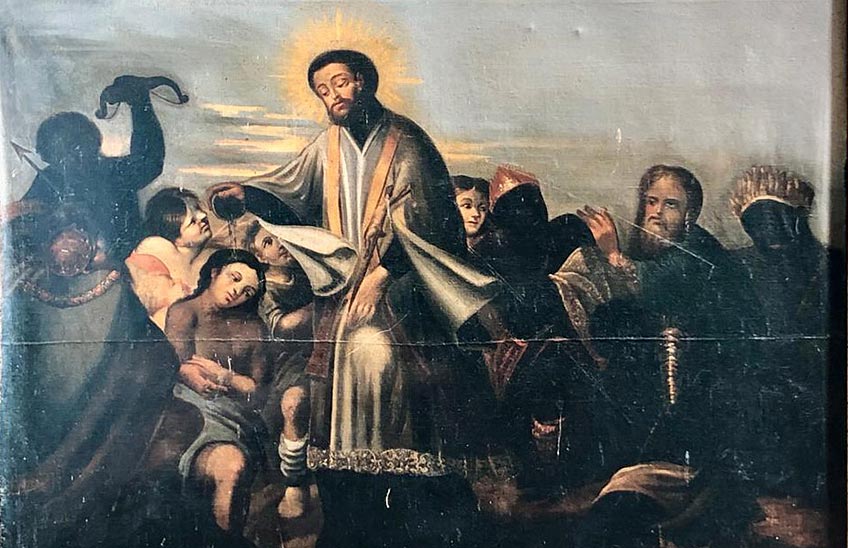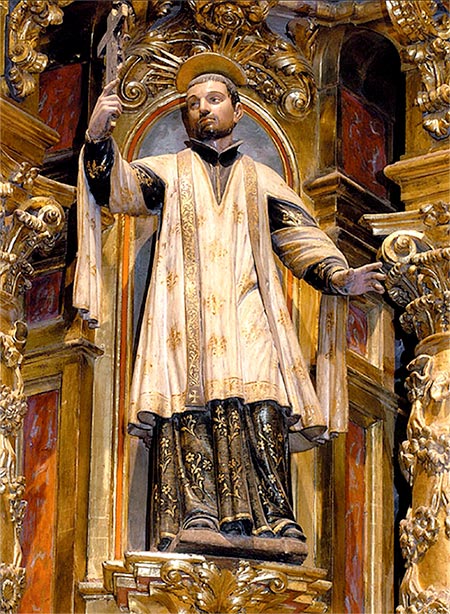The board of trustees of St. Francis Xavier and the monastery of Fitero

PhotoJesúsLatorre/Canvas of Saint Francis Xavier baptising from the monastery of Fitero, end of the 17th century.
The declaration of Saint Francis Xavier as patron saint of Navarre caused great division among the people and institutions of the Kingdom, as in many quarters the secular board of trustees of Saint Fermín was seen to be in danger, especially in the city of Pamplona. In 1657, after more than two decades of litigation, the Roman Pontiff declared both to be "patroni aeque principales". It was then that the struggle between Ferminists and Xavierists between the towns, monasteries and town councils in favour of one saint or the other ceased. Javier had been acclaimed, in general, by the towns of La Ribera and the Diputación of the Kingdom, while Saint Fermin had gained the support of the diocesan clergy, who were rather wary of the growing power of the Society of Jesus.
From the monastery of Fitero, the reply sent to Pamplona on November 16, 1624, was in compliance with the wishes of the Cortes of Navarre that had ratified him as patron saint. In the letter we read: "Attending to the honor that is due to the saints and in particular to St. Francis Xavier, as our Mother the Church sample us and his life and miracles publish, this Royal Convent has had the very good fortune that your most illustrious lordship agrees to send us by your letter of November 5, and more in something so of the service of God and honor of such a great saint to whom, as a son of this Kingdom is very due the degree scroll of patron saint, with which Your Illustrious Lordship honors him and the election has also been agreed as much of his success in everything could be expected. The keeping of the feast of the saint by praying for him, will be put into execution in this our monastery and town of Fitero and in this, as in the rest that is offered, we would like to show how much we wish to serve your most illustrious lordship, whom our Lord will keep and prosper with all increases of happiness, through the intercession of our patron saint, as all these chaplains of his wish". In this reply, the president of the monastic community, Friar Alonso Diez, as the abbey was to be provided for, thanked the Diputación del Reino for the letter, showing his satisfaction in understanding that the missive constituted one more test the possession of the ecclesiastical jurisdiction of the town, against the desires of the bishop of Tarazona.
A couple of decades later, on 12 December 1650, in the midst of the conflict of board of trustees, the town council of Fitero stated that it had granted its power of attorney in favour of San Fermín, with a statement that was not without bitterness, since it was the abbot of the monastery who took part in the Cortes and not the town, as it would have wished. This is how he expressed himself in his reply to the Diputación del Reino: " As I have no vote in the Cortes, I have had no news of your lordship's claim to vote for his sole patron saint the great apostle of India, Saint Francis Xavier, for which reason, two or three weeks ago, a little more or less, the city of Pamplona wrote to me to send me power of attorney to ask to be patron saint to the glorious Saint Fermin and I sent it, and today I find myself with the greatest regret I can..., as I am unable to serve your illustriousness with what you have ordered me to do".
The everlasting tensions between the abbey and the town were once again at play quotation in this matter as well. From 1657 onwards, the celebration of the feast of both saints was carried out in accordance with the decision of the Pope and the Navarrese authorities. In that same year, on 2 July, the abbot of the monastery, Fray Hernando de Ferradillas, wrote to the Diputación del Reino the following text, at reference letter in compliance with the Papal Brief: "in view of all this, it seemed to me that it is right and in our interest to have such illustrious saints as patrons in this Kingdom of yours, they will be celebrated in this monastery and town of Fitero in accordance with what His Holiness orders... and for my part I will make it known to the residents of the town with particular dispatch that will be provided for it so that all with one mouth and one heart we celebrate the feast of such patron saints who deserve it by so many titles...".
To this day, the verses of the dawn are still preserved, the text of which is a testimony that shows how the figure of the saint gradually permeated the popular imagination, establishing himself as a true prodigy and atlantean, as well as a sign of Navarre's identity. If in Baroque literature he was defined as such, even with parallels to the deities of the Greco-Roman pantheon, in the popular verses that were sung to him in the dawn rosary, at the break of day, he was greeted, in tune with the lyrics of the jozos, with verses such as these from Fitero, dated at an imprecise date in the 18th century: "The sun dawns this day/ that fills this Kingdom/ with joy and pleasure/ contemplating gave birth to an apostle/ who converted thousands of souls/ to the faith. / He made the sea give fresh water / and the sun in its turn made it stop". This is a popular embodiment of an idea that had taken root after more than a century of propaganda and worship from the pulpits and choirs of the churches of Navarre, where distinguished Jesuits came to sing the glories of one of their most beloved and popular figures.
In addition to her feast day, the novena of Grace was celebrated until recent times, and the famous "gozos" were performed. The most widespread text for the exercise of the novena in Navarre and in other parts of Spain and Latin America was the one published by Father Francisco García, born in Vallecas in 1640 and author of one of the biographies of the saint, published in Madrid in 1672. Editions of García's novena are known to have been published in Pamplona in 1700, 1721, 1744, 1767, 1847, 1865, 1876 and many others without a year. The way it was done was the usual one in that subject of internship, always before an image or altar of the saint, with an act of contrition, common prayers for all the days and some deprecations for each one of them. Litanies or florilegios were also included, singing the virtues of the saint and, above all, the joys.

Sculpture of Saint Francis Xavier from the altarpiece of Saint Teresa, in the north curcero of the monastery of Fitero, by José Serrano, 1730. Photo J. L. Larrión
The latter were very popular in towns and cities for two main reasons. On the one hand, they constituted a very simple form of learning and catechising, together with sermons, about the significance, life and work of the saint. On the other hand, as they were sung, either with a small chamber orchestra, with organ accompaniment, or simply with human voices, they became the part that aroused most expectation in the many people attending the ceremony, as the most significant moment of the liturgical function.
As in Corella, in the post-abbatial period, the gozos were performed with a very dynamic melody, in connection with the joyful music of Eslava and his time, for male voices with organ accompaniment. The scores from Corella and the copies from Fitero bear the date 1885. The author is unknown, but from other copies, we know that it was the Navarrese organist and composer Mariano García (1809-1869).
As for figurative representations, there was a canvas of the saint being baptised in the monastery from the end of the 17th century, as well as the polychrome wooden sculpture of the altarpiece of Saint Teresa, the work of José Serrano from 1730. The latter was prayed to on her feast days, and lights were placed in front of her by means of candelabra in the shape of a cage, which were raised up to the base of the image by means of pulleys. Both iconographies served to catechise, together with sermons and joys, in an illiterate society in which the means of disseminating culture were mainly oral and plastic.
To find out more
FERNÁNDEZ GRACIA, R., San Francisco Javier Patron Saint of Navarre. Fiesta, religiosidad e iconografía, Pamplona, Government of Navarre, 2006.
